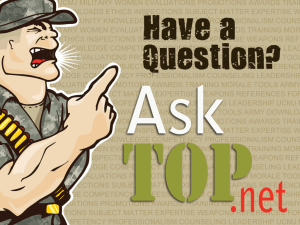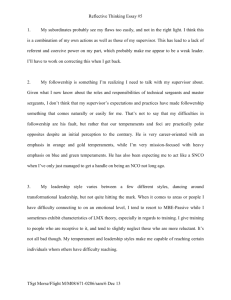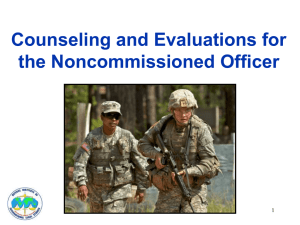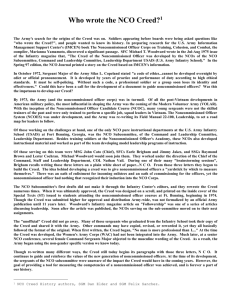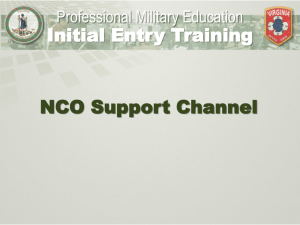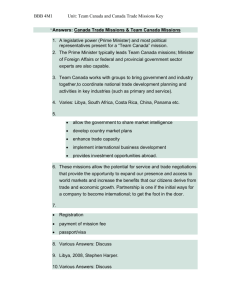Module 1 Lesson 2 Duties, Responsibilities, and Authority of NCOs
advertisement
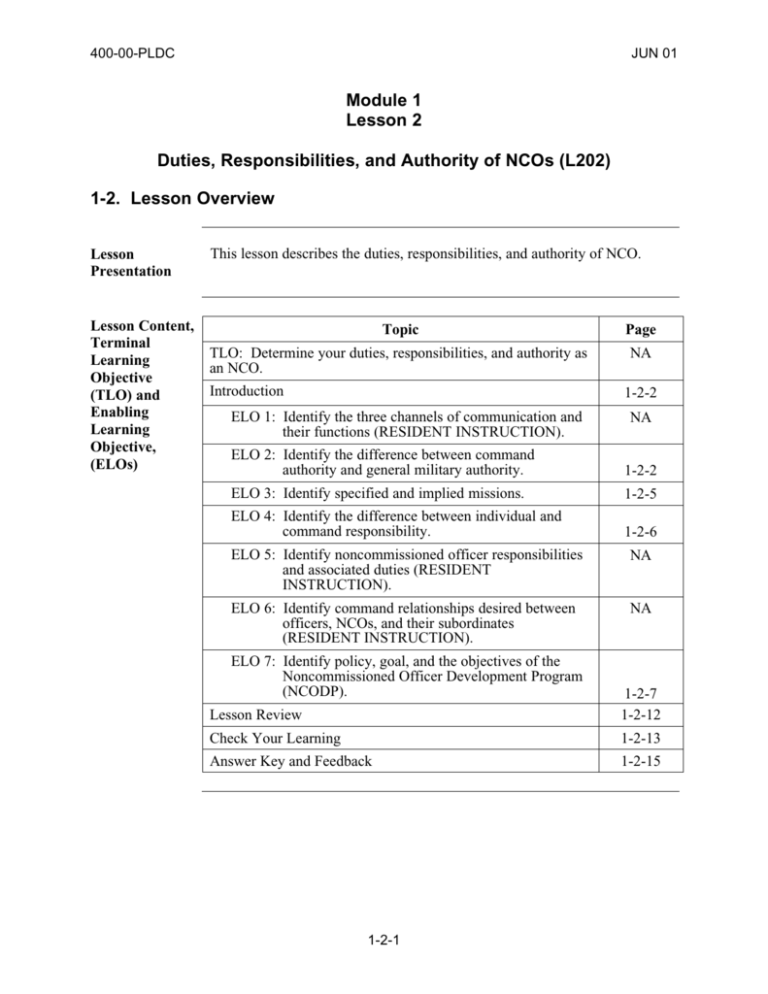
400-00-PLDC JUN 01 Module 1 Lesson 2 Duties, Responsibilities, and Authority of NCOs (L202) 1-2. Lesson Overview Lesson Presentation Lesson Content, Terminal Learning Objective (TLO) and Enabling Learning Objective, (ELOs) This lesson describes the duties, responsibilities, and authority of NCO. Topic Page TLO: Determine your duties, responsibilities, and authority as an NCO. NA Introduction 1-2-2 ELO 1: Identify the three channels of communication and their functions (RESIDENT INSTRUCTION). NA ELO 2: Identify the difference between command authority and general military authority. 1-2-2 ELO 3: Identify specified and implied missions. 1-2-5 ELO 4: Identify the difference between individual and command responsibility. 1-2-6 ELO 5: Identify noncommissioned officer responsibilities and associated duties (RESIDENT INSTRUCTION). NA ELO 6: Identify command relationships desired between officers, NCOs, and their subordinates (RESIDENT INSTRUCTION). NA ELO 7: Identify policy, goal, and the objectives of the Noncommissioned Officer Development Program (NCODP). Lesson Review 1-2-7 1-2-12 Check Your Learning 1-2-13 Answer Key and Feedback 1-2-15 1-2-1 400-00-PLDC References JUN 01 The following table lists the references for this lesson: Number Title Date Para No. May 91 Para 4 thru 6 AR 600-20 Army Command Policy Jul 99 Chap 4, Para 4-8 FM 22-100 Army Leadership Aug 99 Para 1-56, Para 542, and App A AR 350-17 Noncommissioned Officer Development Program (NCODP) 1-2-1. Introduction Purpose This lesson provides information that will help you successfully lead your soldiers on a day-to-day basis and prepare you to be a successful leader on the next battlefield. It discusses the difference between command authority and general military authority, specified and implied missions of a noncommissioned officer, and the difference between individual and command responsibility. This lesson also explains the policy, goal, and objectives of the Noncommissioned Officer Development Program (NCODP). You will receive additional instruction on this material during the resident phase of lesson L202. This material supports the resident lesson and is necessary for you to participate in the resident discussion of this topic. 1-2-2. Identify The Difference Between Command Authority And General Military Authority Introduction You are beginning a very important step in your professional development. PLDC is the first step in the Noncommissioned Officer Education System (NCOES). As a noncommissioned officer, you must know what duties, responsibilities, and authority you have and where it comes from. 1-2-2 400-00-PLDC JUN 01 1-2-2. Identify The Difference Between Command Authority And General Military Authority, cont Definition of Authority Authority is the legitimate power of leaders to direct subordinates or to take action within the scope of their positions. Military authority begins with the Constitution, which divides it between Congress and the president. Congress has the authority to make laws that govern the Army. The president, as commander in chief, commands the armed forces, including the Army. There are two types of military authority--"command' and "general military." Command Authority Command authority is the authority leaders have when they are in a command-designated position that requires direction and control of other soldiers. Command is the authority that a commander in the armed forces lawfully exercises over subordinates by virtue of rank or assignment. Command includes the authority and responsibility for effectively using available resources to organize, direct, coordinate, employ, and control military forces so that they accomplish assigned missions. It also includes responsibility for the health, welfare, morale, and discipline of assigned personnel. Command authority originates with the president and may be supplemented by law or regulation. It is the authority that a commander lawfully exercises over subordinates by virtue of rank or assignment. Only commissioned and warrant officers may command Army units and installations. DA civilians may exercise general supervision over an Army installation or activity; however, they act under the authority of a military supervisor. DA civilians do not command. Army leaders are granted command authority when they fill commanddesignated positions. These normally involve the direction and control of other soldiers and DA civilians. Leaders in command-designated positions have the inherent authority to issue orders, carry out the unit mission, and care for both military members and DA civilians within the leader’s scope of responsibility. General Military Authority General military authority originates in oaths of office, law, rank structure, traditions, and regulations. This broad-based authority also allows leaders to take appropriate corrective actions whenever a member of any armed service, 1-2-3 400-00-PLDC JUN 01 1-2-2. Identify The Difference Between Command Authority And General Military Authority, cont General Military Authority anywhere, commits an act involving a breach of good order or discipline. AR 600-20, paragraph 4-5, states this specifically, giving commissioned, warrant, and noncommissioned officers authority to "quell all quarrels, frays, and disorders among persons subject to military law"--in other words, to maintain good order and discipline. An example of this is when an NCO makes an on the spot correction of a soldier from another unit All enlisted leaders have general military authority. For example, dining facility managers, platoon sergeants, squad leaders, and tank commanders all use general military authority when they issue orders to direct and control their subordinates. Army leaders may exercise general military authority over soldiers from different units. For NCOs, another source of general military authority stems from the combination of the chain of command and the NCO support channel. The chain of command passes orders and policies through the NCO support channel to provide authority for NCOs to do their job. As a noncommissioned officer, you have both general military authority and the duty to enforce policies and regulations. Failure to exercise your general military authority is neglecting your duty for which you can be held accountable. Another source of authority for NCOs stems from the combination of the chain of command and the NCO support channel. The chain of command passes orders and policies through the NCO support channel to provide authority for NCOs to do their job. Delegation of Authority Just as Congress and the president cannot participate in every aspect of armed forces operations, most leaders cannot handle every action directly. To meet the organization’s goals, officers delegate authority to NCOs and, when appropriate, to DA civilians. These leaders, in turn, may further delegate that authority; leaders may delegate authority in whole or in part, unless limited by law. 1-2-4 400-00-PLDC JUN 01 1-2-3. Identify Specified and Implied Missions Description of Duty As a noncommissioned officer, you have duties and responsibilities. As you review this material, keep in mind that your ultimate objective is to understand how duties and responsibilities interrelate. Duty begins with everything required of you by law, regulation, and orders; but it includes much more than that. You must commit yourself to excellence in all aspects of your professional responsibility. That way, when you have accomplished the mission, you can look back and say, “I couldn’t have given any more.” You as a leader must take the initiative, figuring out what needs to be done before being told what to do. As a leader you should never shade the truth, but follow your higher duty to the Army and the nation. It is your duty as a leader to take charge, even in unfamiliar circumstances. In extremely rare cases, you may receive an illegal order. Duty requires you to refuse to obey it. As a good leader you execute the boss’s decisions and orders with energy and enthusiasm, the exception to this principle is your duty to disobey illegal orders. This is not a privilege you can conveniently claim, but a duty you must perform. If you think an order is illegal, first be sure that you understand both the details of the order and its original intent. First, you should seek clarification from the person issuing the order. If time permits seek legal counsel, if not, make the best judgment possible. Definition of Duty Duties fall into two separate mission categories • • Specified missions Implied missions Specified Missions Specified missions come from your boss or higher headquarters and or specifically charged to an individual in official publications or orders. Implied Missions Implied missions are those duties covering all aspects of an individual’s job that are not spelled out, yet are vital to mission accomplishment. They 1-2-5 400-00-PLDC JUN 01 1-2-3. Identify Specified and Implied Missions, cont Implied Missions, continued include the multitude of implied tasks involved in leadership and motivation which not only get the job done, but done better causing the unit to function at an optimum level. In most cases, the accomplishment of implied missions depend upon individual initiative. For example, while in the motor pool, fuel becomes available to top off your unit's vehicles. You ensure all the drivers in your unit top off all the vehicles. Your initiative assists in mission accomplishment. This is another example. During the duty day, you recognize free time is available from regular duties. You decide to provide additional training during this free time. This training assists in unit and Army mission accomplishment. A soldier may or may not have someone tell him to accomplish implied missions. He normally just does them or fails to do them. Implied missions are usually people oriented and concern every aspect of safe mission accomplishment. Often you will complete implied missions to identify mission hazards. 1-2-4. Identify The Difference Between Individual And Command Responsibility Introduction No definitive lines separate officer, NCO, and DA civilian responsibilities. Officers, NCOs, and DA civilians lead other officers, NCOs, and DA civilians and help them carry out their responsibilities. Commanders set overall policies and standards, but all leaders must provide the guidance, resources, assistance, and supervision necessary for subordinates to perform their duties. Similarly, subordinates must assist and advise their leaders. Mission accomplishment demands that officers, NCOs, and DA civilians’ work together to advise, assist, and learn from each other. Responsibilities fall into two categories--"command" and "individual." 1-2-6 400-00-PLDC JUN 01 1-2-4. Identify The Difference Between Individual And Command Responsibility, cont Individual Responsibility All soldiers and DA civilians must account for their personal conduct. Commissioned officers, warrant officers, and DA civilians assume personal responsibility when they take their oath. DA civilians take the same oath as commissioned officers. Soldiers take their initial oath of enlistment. Members of the Army account for their actions to their fellow soldiers or coworkers, the appointed leader, their unit or organization, the Army, and the American people. Here is an example. An Army member must have sufficient funds in his account when he writes a check. If the bank returns a member's check for lack of funds, he is responsible, not the superior. In other words, the individual is responsible for what he does, not his leader. Command Responsibility Command responsibility refers to collective or organizational accountability and includes how well units perform their missions. For example, a company commander is responsible for all the tasks and missions assigned to his company; his leaders hold him accountable for completing them. Military and DA civilian leaders have responsibility for what their sections, units, or organizations do or fail to do. Role of the NCO NCOs, the backbone of the Army, train, lead, and take care of enlisted soldiers. They receive their authority from their oaths of office, law, rank structure, traditions, and regulations. This authority allows them to direct soldiers, take actions required to accomplish the mission, and enforce good order and discipline. NCOs represent officer, and sometimes DA civilian, leaders. They ensure their subordinates, along with their personal equipment, are prepared to function as effective unit and team members. While commissioned officers command, establish policy, and manage resources, NCOs conduct the Army’s daily business 1-2-5. Identify the Policy, Goal and Objectives of the Noncommissioned Officer Development Program (NCODP) NCODP Policy As a noncommissioned officer, you should understand the Noncommissioned Officer Development Program (NCODP). 1-2-7 400-00-PLDC JUN 01 1-2-5. Identify the Policy, Goal and Objectives of the Noncommissioned Officer Development Program (NCODP), cont NCODP Policy, continued The NCODP is a hands-on program, tailored to the unique requirements of the unit. As with all leader training, the NCODP is a command responsibility. The program reflects command priorities and expectations for leader development, jointly determined by commanders and their senior NCOs. It is a battalion, separate company, or equivalent level program and is equally applicable to both table of organization and equipment units (TO&E) and table of distribution and allowances (TDA) units. The NCODP consists of training programs, formal and informal, one-on-one or groups, involving coaching as well as instruction, and will be fully integrated into the daily routine of the unit. The NCODP builds upon the contributions of the Army’s Enlisted Personnel Management System and the sequential and progressive design of the Noncommissioned Officer Education System. These two systems provide a valuable foundation for the development of NCOs; however, it is through the application of values, attributes, skills, and actions (VASA) in the unit that soldiers become quality NCOs. Goal of NCODP The goal of the NCODP is to increase and sustain NCO combat readiness at the highest possible level. Objectives of NCODP The objectives of the NCODP are to: • • • • • • Develop and strengthen leadership skills and professional attributes within the NCO Corps. Provide guidance in the continuing development of NCOs by taking advantage of opportunities to send leaders to appropriate and affordable technical, developmental, skill qualification, and confidence building courses. Increase confidence of the NCO through identification for and assignments to positions of greater responsibility as the NCO develops and demonstrates increased leadership ability. Realize the full potential of the NCO support channel. Increase unit effectiveness and combat readiness through improving NCO quality, morale, performance, and potential. Foster a unit environment that enhances continued NCO leader development. 1-2-8 400-00-PLDC JUN 01 1-2-5. Identify the Policy, Goal and Objectives of the Noncommissioned Officer Development Program (NCODP), cont Responsibilities Commanders of battalions, separate companies, and equivalent organizations will: • • • • • • Be responsible to develop and implement an effective NCODP. Ensure the program supports the unit mission and enhances development of noncommissioned officers (NCOs). Ensure that the program has stated objectives with measurable and reachable standards. Ensure time and other resources are provided for the conduct of the NCODP. Tailor directives for the unit’s NCODP on doctrine, tactics, techniques, and procedures relating to battle focused training and mission essential task list (METL). Be responsive to the professional needs of the unit’s NCOs in conjunction with the values, attributes, skills, and actions (VASA) required at each NCO skill level. Command sergeants major (CSM), first sergeants, or senior NCOs of battalions, separate companies, or equivalent organizations will: • • • • • NCO Support Channel Advise the commander on all aspects of the NCODP. Implement the commander's directives and guidance on the unit's NCODP. Be responsible for content, pertinence, and implementation of the unit's NCODP. Assess the NCODP utilizing the program goal and objectives stated in this regulation. Provide feedback to the unit commander concerning the NCODP effectiveness as part of the training evaluation process. The NCO support channel parallels and reinforces the chain of command. NCO leaders work with and support the commissioned and warrant officers of their chain of command. For the chain of command to work efficiently, the NCO support channel must operate effectively. At battalion level and higher, the NCO support channel begins with the command sergeant major, extends through first sergeants and platoon sergeants, and ends with section chiefs, squad leaders, or team leaders 1-2-9 400-00-PLDC JUN 01 1-2-5. Identify the Policy, Goal and Objectives of the Noncommissioned Officer Development Program (NCODP), cont NCO Support Channel, cont The connection between the chain of command and NCO support channel is the senior NCO. Commanders issue orders through the chain of command, but senior NCOs must know and understand the orders to issue effective implementing instructions through the NCO support channel. Although the first sergeant and command sergeant major are not part of the formal chain of command, leaders should consult them on all individual soldier matters Successful leaders have a good relationship with their senior NCOs. Successful commanders have a good leader-NCO relationship with their first sergeants and command sergeants major. The need for such a relationship applies to platoon leaders and platoon sergeants as well as to staff officers and NCOs. Senior NCOs have extensive experience in successfully completing missions and dealing with enlisted soldier issues. Also, senior NCOs can monitor organizational activities at all levels, take corrective action to keep the organization within the boundaries of the commander’s intent, or report situations that require the attention of the officer leadership. A positive relationship between officers and NCOs creates conditions for success. 1-2-10 400-00-PLDC JUN 01 THE COMMISSIONED OFFICER • • • • Commands, establishes policy, and manages Army resources. Integrates collective, leader, and soldier training to accomplish missions. Deals primarily with units and unit operations. Concentrates on unit effectiveness and readiness. THE WARRANT OFFICER • • • • • • Provides quality advice, counsel, and solutions to support the command. Executes policy and manages the Army's systems. Commands special purpose units and task-organized operational elements. Focuses on collective, leader, and individual training. Operates, maintains, administers, and manages the Army's equipment, support activities, and technical systems. Concentrates on unit effectiveness and readiness. THE NONCOMMISSIONED OFFICER • • • • Trains soldiers and conducts the daily business of the Army within established policy. Focuses on individual soldier training. Deals primarily with individual soldier training and team leading. Ensures that subordinate teams, NCOs, and soldiers are prepared to function as effective unit and team members. THE DEPARTMENT OF THE ARMY CIVILIAN • • • • Establishes and executes policy, leads people, and manages programs, projects, and Army systems. Focuses on integrating collective, leader, and individual training. Operates, maintains, administers, and manages Army equipment and support, research, and technical activities. Concentrates on DA civilian individual and organizational effectiveness and readiness. Figure 1-1-2. Roles and Responsibilities of Commissioned, Warrant, Noncommissioned, and DA Civilian Leaders 1-2-11 400-00-PLDC JUN 01 1-2-6. Lesson Review During this part of the lesson you identified: • • • • The difference between command authority and general military authority. Specified and implied missions. The difference between individual and command responsibilities. The policy, goal, and objectives of the Noncommissioned Officer Development Program (NCODP). In the resident part of this lesson, you will receive additional instruction on the duties, responsibilities, and authority of NCOs. As a leader, you must execute your duties and responsibilities within the guidelines presented in this lesson and the references listed in the overview. Remember, your failure to properly execute your duties and responsibilities will have a negative effect on both your soldiers and your unit, and could lead to adverse actions against you. 1-2-12 400-00-PLDC JUN 01 1-2-7. Check Your Learning Directions This is a self-graded exercise. Circle the letter of the correct response or fill in the blank with the correct response. Upon completion, compare your responses to the correct responses in the answer key and feedback sheet. Question 1 What type of military authority includes the responsibility to organize, direct, coordinate, employ, and control military forces? a. b. c. d. Question 2 What type of authority is an NCO exercising when he stops a soldier from another unit to make an on the spot correction? a. b. c. d. Question 3 Directed. Command. Specified. General military. What type of authority do all enlisted leaders have? a. b. c. d. Question 4 Command. Designated. Legal. Specified. Directed. Command. Specified. General military. SGT James gave his squad member a task verbally and in writing regarding charge of quarters. Which of the following describes this type of mission? a. b. c. d. Identified. Specified. Applied. Implied. 1-2-13 400-00-PLDC JUN 01 1-2-7 Check Your Learning, cont Question 5 When SGT James takes his APFT, what type of duty is he performing? a. b. c. d. Question 6 Doing something with out being told to, to correct a discrepancy, is an example of what type of duty? a. b. c. d. Question 7 Individual. Command. Charismatic. Collective. Which responsibility makes soldiers responsible for what they do, not the leader? a. b. c. d. Question 9 Individual. Specified. Command. Implied. “All soldiers and civilians must account for their personal conduct”, describes which type of responsibility? a. b. c. d. Question 8 Identified. Specified. Directive. Implied. Individual. Command. Charismatic. Collective. What is “command responsibility”? a. b. c. d. Being responsible for all tasks and missions assigned to a unit. Having charismatic power Being responsible for your individual actions and conduct. Reserved for noncommissioned officers in charge. 1-2-14 400-00-PLDC JUN 01 1-2-8 Answer Key and Feedback Sheet Question 1 Correct response is: a. Command, Ref: Command Authority, Second Paragraph, p 1-2-3 Question 2 Correct response is: d. General military, Ref: General Military Authority, First Paragraph, p 1-2-4 Question 3 Correct response is: b. General military, Ref: General Military Authority, Second Paragraph, p 1-2-4 Question 4 Correct response is: b. Specified, Ref: Specified Missions, p 1-2-5. Question 5 Correct response is: b. Specified, Ref: Specified Missions, p 1-2-5.. Question 6 Correct response is: d. Implied, Ref: Implied Missions, p 1-2-5. Question 7 Correct response is: a. Individual, Ref: Individual Responsibility, First Paragraph, p 1-2-7. Question 8 Correct response is: a. Individual, Ref: Individual Responsibility, p 1-2-7. Question 9 Correct response is: a. Being responsible for all tasks and missions assigned to a unit, Ref: Command Responsibility, p 1-2-7. 1-2-15
